Physical Address
304 North Cardinal St.
Dorchester Center, MA 02124
Physical Address
304 North Cardinal St.
Dorchester Center, MA 02124
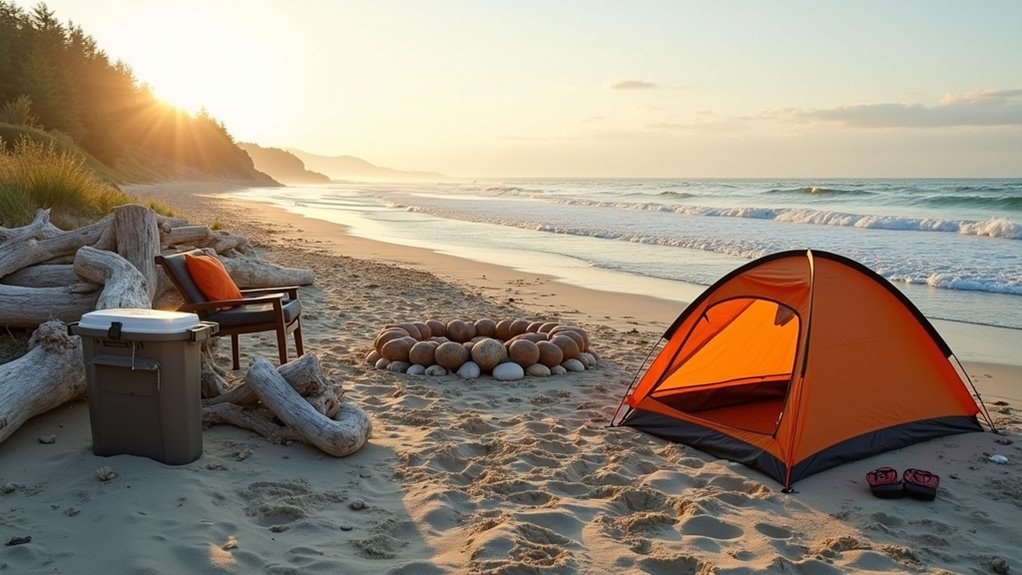
Beach camping requires strategic planning to avoid sandy disasters—discover the 8 essential tips that separate dreamy coastal adventures from complete failures.
You’ve probably dreamed of waking up to ocean waves and falling asleep under star-filled skies, but beach camping isn’t as simple as pitching your tent in the sand. The salt air, unpredictable tides, and coastal winds create unique challenges that can turn your perfect getaway into a sandy nightmare if you’re unprepared. With the right approach and some insider knowledge, you can avoid the common pitfalls that catch most first-time beach campers off guard.
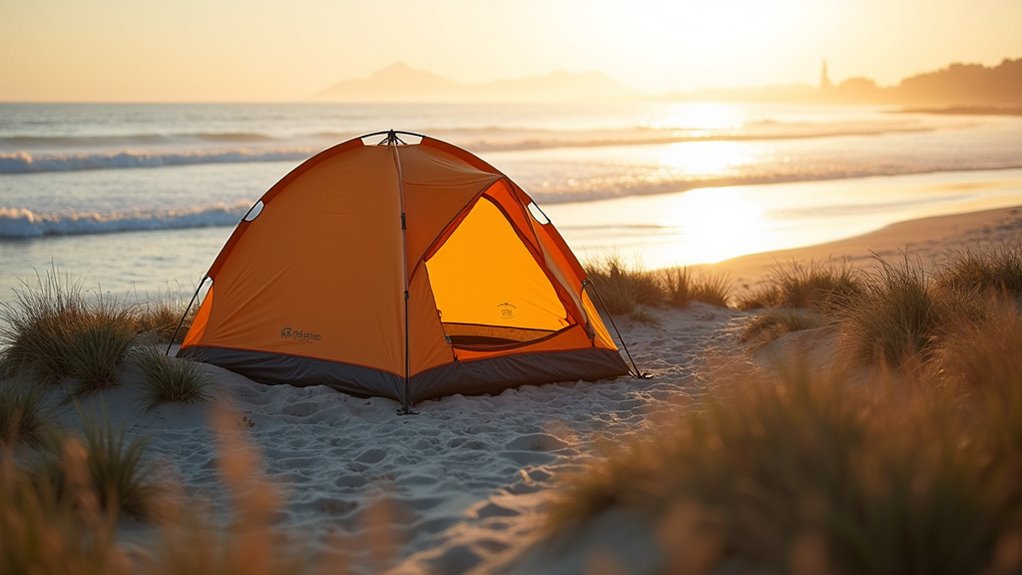
When you’re scouting beach campsites, timing can make or break your entire trip. Arrive during weekdays if possible – you’ll snag better spots and pay less.
Timing your beach camping arrival strategically during weekdays ensures premium campsite selection while keeping costs down.
Scout locations during low tide to see the full beach layout and avoid setting up where high tide might reach.
Look for natural windbreaks like dunes or vegetation to shield your tent from constant ocean breezes.
Check local regulations first; many beaches require permits or restrict camping to designated areas.
Avoid spots directly under cliffs where rocks might fall.
Position yourself close enough to enjoy ocean sounds but far enough from the water line for safety.
Consider sunrise and sunset directions when choosing your tent’s orientation – you don’t want morning sun blazing directly into your shelter.
If you’re using a self-contained camping trailer, ensure your chosen spot has level ground and adequate space for setup while maintaining proper distance from the high tide line.
Since beach winds can turn a relaxing camping trip into a wrestling match with your gear, you’ll need equipment that won’t fold under pressure. Coastal gusts can reach 20-30 mph regularly, so standard camping gear won’t cut it.
Invest in these wind-resistant essentials:
You don’t need the most expensive gear, but skimping on wind resistance will cost you sleep and sanity. If you’re looking for inspiration beyond beach camping, Scotland’s West Highland Way offers some of the world’s most spectacular hiking experiences with its own unique weather challenges.
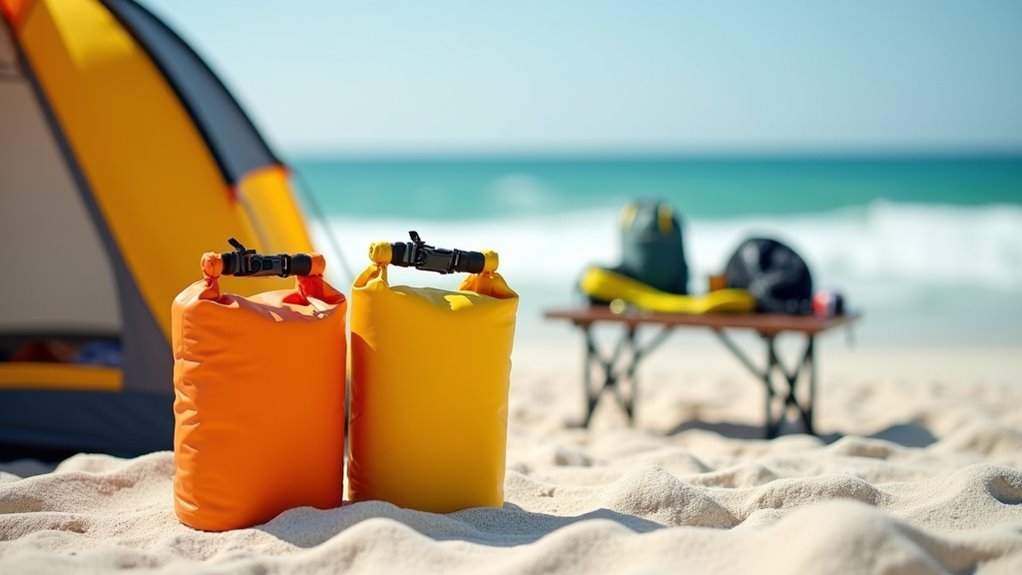
Beach environments assault your gear with a double threat that’ll turn your favorite camping equipment into expensive paperweights if you’re not careful. Sand infiltrates every zipper, pocket, and crevice, while salt air corrodes metal components faster than you’d imagine.
Pack everything in sealed plastic bags or airtight containers. Use ziplock bags for electronics, dry bags for clothing, and waterproof cases for cameras.
Wipe down metal gear daily with fresh water if available, or baby wipes as a backup.
Keep tent zippers closed constantly – even a brief opening invites sand invasion. Store cooking equipment in covered bins between uses. Don’t leave anything exposed overnight; salt-laden dew accelerates corrosion.
Consider bringing cheaper backup versions of essential items you can’t afford to lose.
When RV camping at the beach, position your vehicle to shield sensitive equipment from direct salt spray carried by ocean winds.
Unless you’ve tried pitching a tent in loose sand, you can’t appreciate how frustrating standard tent stakes become in beach conditions. Regular stakes simply won’t hold in shifting sand, leaving your tent flapping like a flag in coastal winds.
Here’s what actually works for sand anchoring:
You’ll also want longer guy-lines than usual since your anchor points need greater distance from your tent for proper holding angles. Once your shelter is secure, set up a sturdy camping table to serve as your base for meal prep and gear organization throughout your beach adventure.
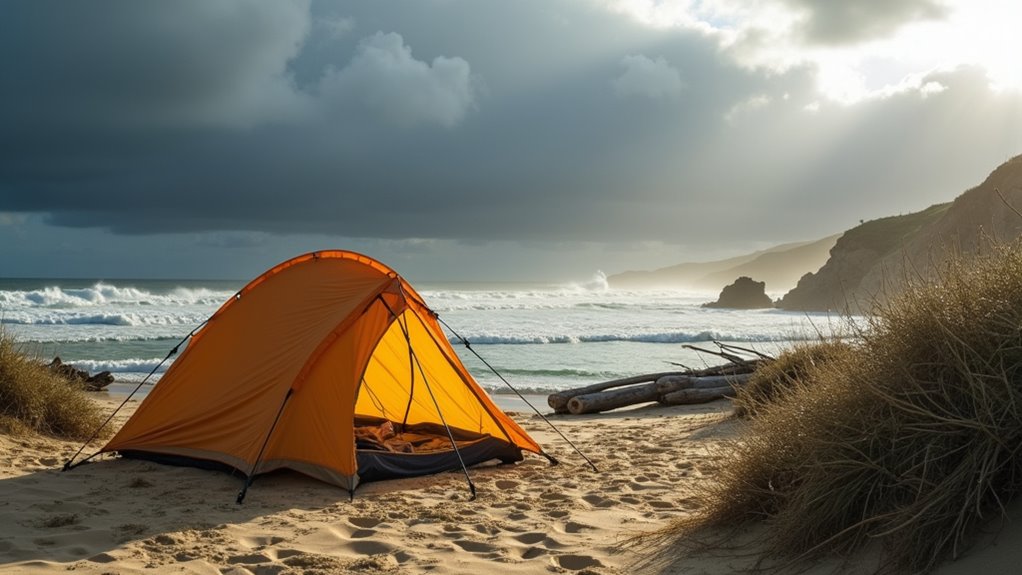
While you might check the weather forecast before any camping trip, coastal conditions demand extra vigilance since they can shift dramatically within hours. Download weather apps that track wind patterns, tide schedules, and storm alerts specific to your beach location.
Coastal weather changes fast—download specialized apps to track winds, tides, and storm alerts for your specific beach location.
Ocean breezes can turn into powerful gusts overnight, while morning fog might roll in unexpectedly.
Pack layers for temperature swings – beaches get surprisingly cold after sunset. Bring a waterproof tarp as backup shelter and extra guy-lines for your tent.
Check tide charts to avoid camping in flood zones during high tide. Monitor wind direction changes that could bring salt spray or sand into your campsite.
Keep one eye on offshore clouds throughout your stay, and don’t hesitate to relocate inland if conditions deteriorate rapidly.
If you’re planning to extend your camping adventures beyond beach locations, consider exploring winter camping destinations that offer unique challenges and stunning snow-covered landscapes.
What separates successful beach campers from those who pack up early? The right gear makes all the difference between comfort and misery on coastal adventures.
You’ll need supplies that handle sand, salt, and moisture without breaking your budget. Skip expensive “beach-specific” marketing and focus on practical essentials that actually work.
Must-have supplies for beach camping:
Don’t forget to include camping toilets in your essential gear list, as proper sanitation facilities are crucial for extended beach stays.
Smart packing means bringing versatile items that serve multiple purposes, saving space and money.
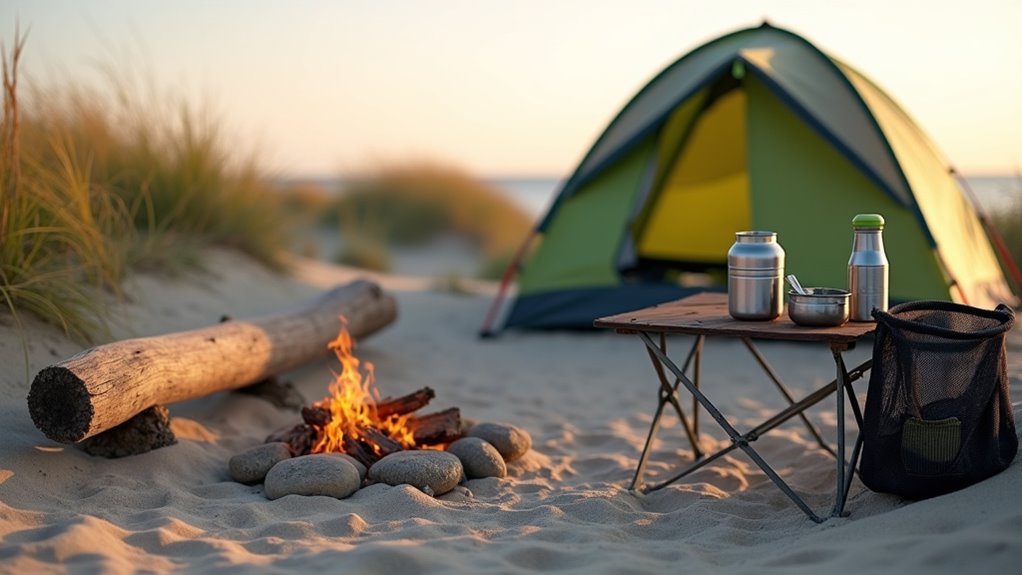
Beach ecosystems face unique pressures from camping activities, so you’ll need to adapt standard Leave No Trace practices to protect fragile coastal environments.
Camp only on durable surfaces like sand above the high-tide line, avoiding dunes and vegetation. These areas prevent erosion and protect nesting sites for sea turtles and shorebirds.
Pack out everything you bring, including food scraps that attract scavenging wildlife. Bury human waste 6-8 inches deep and 200 feet from water sources. Use biodegradable soap sparingly for washing dishes.
Respect wildlife by observing from a distance and never feeding animals. Keep noise levels down, especially during dawn and dusk when wildlife is most active.
Leave shells, rocks, and driftwood where you found them—they’re essential habitat components that maintain the coastal ecosystem’s natural balance.
The key principle is to leave nothing behind when you pack up your coastal campsite, ensuring future visitors can enjoy the same pristine beach environment.
Since coastal waters can shift dramatically within hours, you’ll need to understand tidal patterns before setting up camp. Check local tide charts and weather forecasts before your trip – they’re free online or at visitor centers. Position your tent well above the high-tide line, typically 50+ feet from the water’s edge.
Water safety requires constant vigilance around unpredictable ocean conditions:
Never turn your back on waves, supervise children constantly, and designate a water-watching buddy system. Strong currents and sneaker waves can appear without warning, even on calm days. Beach camping also brings increased mosquito activity near water sources, so pack mosquito repellent to ensure comfortable evenings by the shore.
Remember, practice makes perfect when it comes to beach camping. You’ll master these techniques with each trip while keeping costs down by reusing gear and choosing free campsites. Don’t let minor setbacks discourage you—every experienced camper’s learned through trial and error. Focus on the essentials: safe setup, weather preparation, and environmental respect. You’ve got everything you need for an amazing coastal adventure without breaking the bank. Start planning your next beach camping trip today!